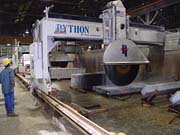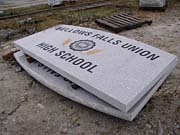
The beginnings of Fletcher Granite Co., LLC, date back to 1881, when the company H.E. Fletcher Co. began extracting granite from a small quarry in Westford, MA. Today, the company extracts 11 stones from a total of 10 quarries, and it has a large fabrication plant that ships finished stone products throughout the U.S. and abroad.
The quarry in Westford yields Chelmsford Grey, a light gray stone of fine to medium grain, highlighted by small black flakes. The quarry has been in continuous operation since 1881, even staying open during both World Wars when other quarries were shut down. During these times, it also furnished ballast for ships in addition to its regular product line.
Stone is extracted with twist wires and a loose abrasive system. During the extraction process, massive sections of stone are “opened†or prepared for sawing with oxygen burners, which create channels that run down two sides of a particular section that is to be sawn. The stone between the burned channels is then quarried in a traditional manner to facilitate setting the saw towers. Then, large towers -- each fitted with 8 to 10 wires -- create horizontal cuts. To finally free the stone, a pin is inserted into the slabs of stone, and they are lifted out of the quarry as needed. Overall, it takes eight or nine weeks to prepare a defined section and extract the stone from a specific location within the quarry.
The quarry can operate year round. Although the wire saws do not operate when it is below freezing, the oxygen burners can work at any temperature. Since Fletcher fabricates a broad range of products, even cobblestones, the company has very low waste in the quarries.
In addition to the Chelmsford Grey granite, Fletcher Granite Co. quarries a broad range of granites, including Addison Black in Addison, ME; Deer Isle® in Stonington, ME; Englishman Bay and Jonesboro in Jonesboro, ME; Kitledge Grey in Milford, NH; Madison in Madison, NH; Milford Pink in Hopkinton, MA; Silver Cloud Imperial™ in Conyers, GA; and Tapestry in Milford, NH.
Fletcher has four quarry crews in all: one in Westford, one that works in Maine and northern New Hampshire, one in Milford, NH, and one in Georgia.
Many of the granites split well, according to John Barretto, Jr., the company's sales manager for dimension stone. As a result, the company is able to use hydraulic splitters to split materials up to 4 feet in height, which is a much less expensive alternative to sawing on some projects, and suitable for split or rock pitched finishes.

Fabricating operations
Stone fabrication takes place at a facility that was originally built in the 1930s and has undergone numerous additions over the years. However, growth has been thoughtfully planned out, and material flows through the various processing stages in a very orderly fashion.Barretto explained that the fabrication plant is actually two mills in one, since half the plant is for architectural work and slabbing, while the other side is for curbing. The facility has a broad range of equipment, some units manufactured by leading firms in the U.S. and Europe, and others designed, engineered and built by Fletcher Granite Co.
On the architectural/slabbing side, blocks are processed in two basic ways. One option is using wire sawing equipment from Wires Engineering. The company has a multi-wire saw that can cut up to 10 slabs simultaneously, as well as a single-wire model that is used for larger pieces and odd-shaped blocks.
Blocks are also processed on large disc saws from Park Industries that feature blades as large as 3 meters. In addition to these saws, the company has Park Industries Python disc saws for larger slab dimension work. These units have a working head capable of intricate cuts. For example, they processed jobs such as the fountain bowls for Goldman Sachs, where the machines executed step cutting operations to shape the bowl. Additionally, the company operates two fully articulating GMM bridge saws from Italy for processing smaller pieces.
For polishing, the company has a Thibaut T502 automatic bed polisher from France, which can polish several large flat slabs at one time, automatically changing the polishing bricks as needed. A radial arm polisher from Thibaut is also used for surface polishing of smaller stone pieces.
Since thermal-finished stone remains a popular request among the company's customers, an automated flaming machine receives slabs on a conveyor line.
The curbing operations first require the stone to be split to the proper dimensions. This is done with Park Industries Hydra-Split machines as well as company-made radius splitting equipment, including machinery that can split on a 2-foot radius as well as a 5-foot radius. The radial joints are then cut on one of many two-head cut-off saws. “There is very little hand cutting in a piece of curb,†Barretto explained.
“Curbing can be simple, or it can be complicated if it is not done right,†added Bill Walker, who heads curbing sales for Fletcher Granite Co. According to Walker, when the company receives a curbing order, less than half can be taken directly from stock, with the remainder being custom cut to some extent.
The company does stock a large amount of curbing, although every state has its own unique specifications. For Chelmsford Grey curbing, the stone that is used is actually sawn within the quarry to dimensions that are smaller than a typical block, and the stone slabs are then transported by rail to the factory.
A total of 60 to 65 workers are in the plant, many of whom have 25 to 30 years of experience with the company, and Fletcher Granite Co. has 150 employees in all.
Markets
On the architectural side, Fletcher Granite Co. has been involved in many commercial, institutional and civic projects, such as 1717 Pennsylvania Avenue and the Shrine of the Immaculate Conception in Washington, DC; Suffolk Law School in Boston, MA; the Palace of the Legion of Honor in San Francisco, CA; and the Winchester Library Addition in Winchester, MA.For architectural work, every piece is drawn and detailed by the company's highly specialized drafting department. This includes shop drawings as well as work tickets for the cutter that include all of the necessary details, “right down to the anchoring,†according to Barretto.
At the time of Stone World's visit to Fletcher Granite Co., the company was busy fabricating a broad range of exterior projects, including Tapestry granite curbing and planter units for Battery Park City in New York as well as two Boston city park projects -- North Point Park and Nashua Street Park, both part of the Charles River Basin Park program associated with the Central Artery project in Boston. “When you are dealing with public works and parks, the architect has stone in mind from the beginning,†Barretto said. “These parks have been integral to our dimension stone backlog being very healthy.†For all projects, the pieces are carefully laid out in the company's stockyard, and they are labeled with the job number and block number.
Fletcher Granite Co. also fabricates granite posts and signage, and another market for stone is the “hardening†of federal buildings, where bollards, planters, etc. are added to the exterior features of a building to protect it from terrorism.
In addition to work within the U.S., Fletcher Granite Co. has also done work for projects in London, such as Canary Wharf, and in Germany, where the company supplied blocks of stone for the I.M. Pei-designed German Historical Museum in Berlin. It is currently working on potential projects in the Far East as well.
In the future, it is important for Fletcher Granite Co. to continue in curbing and thick dimension stone work, but there is room for other growth, explained company CEO Jon Maurer. “The dimensional stone business has tremendous potential, although not every aspect of the business will be done by us,†he said. “Ultimately, we may partner with others to do other types of jobs, such as thinner pieces for large cladding jobs and work on the West Coast. We can create a network of people to combine stone and knowledge of technologies.â€
As for new machinery, the company has an eye on investments in radius cutting equipment or CNC technology, but it will wait for the market demand to dictate the need. “Our current project demand has not dictated a need to shift,†Maurer said. “Knowing our niche is important.â€
